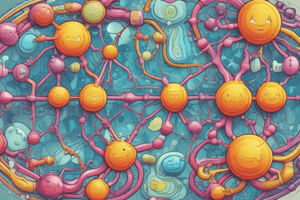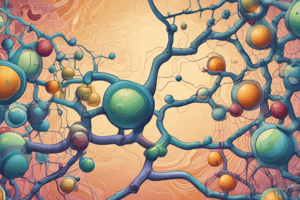Podcast
Questions and Answers
During the hydration step of β-oxidation, what is added to the double bond at the beta carbon?
During the hydration step of β-oxidation, what is added to the double bond at the beta carbon?
- A -CH3 group
- A -NH2 group
- A -OH group (correct)
- A -COOH group
What molecule is used in the hydration step of β-oxidation?
What molecule is used in the hydration step of β-oxidation?
- CoA
- NADH
- H2O (correct)
- FADH2
How many acetyl-CoA molecules are produced from the breakdown of one C16 fat (palmitate)?
How many acetyl-CoA molecules are produced from the breakdown of one C16 fat (palmitate)?
- 6
- 9
- 7
- 8 (correct)
Which enzyme is involved in the acyl transfer step of β-oxidation?
Which enzyme is involved in the acyl transfer step of β-oxidation?
What is the primary purpose of β-oxidation of fats?
What is the primary purpose of β-oxidation of fats?
In the third step of β-oxidation, what is the hydroxyl group converted into?
In the third step of β-oxidation, what is the hydroxyl group converted into?
How much ATP is produced from the complete metabolism of one palmitate molecule?
How much ATP is produced from the complete metabolism of one palmitate molecule?
How many β-oxidation cycles are needed to fully break down a C16 fat (palmitate)?
How many β-oxidation cycles are needed to fully break down a C16 fat (palmitate)?
What is the net gain of ATP from glycolysis?
What is the net gain of ATP from glycolysis?
How many turns of the TCA cycle are required to completely oxidise one glucose molecule?
How many turns of the TCA cycle are required to completely oxidise one glucose molecule?
What does dihydroxyacetone phosphate (DHAP) isomerize into during fat degradation?
What does dihydroxyacetone phosphate (DHAP) isomerize into during fat degradation?
Which molecule is involved in the transport of fatty Acyl-CoA into the mitochondrial matrix?
Which molecule is involved in the transport of fatty Acyl-CoA into the mitochondrial matrix?
During which step of $eta$-oxidation is a double bond formed between the alpha and beta carbons?
During which step of $eta$-oxidation is a double bond formed between the alpha and beta carbons?
What is the final product of the $eta$-oxidation pathway of fatty acids?
What is the final product of the $eta$-oxidation pathway of fatty acids?
What are the main molecules produced during the $eta$-oxidation of Acetyl-CoA?
What are the main molecules produced during the $eta$-oxidation of Acetyl-CoA?
What does the combination of fatty acid, CoA, and ATP produce?
What does the combination of fatty acid, CoA, and ATP produce?
Where does fatty acid synthesis occur?
Where does fatty acid synthesis occur?
What is the enzyme responsible for converting acetyl-CoA to malonyl-CoA?
What is the enzyme responsible for converting acetyl-CoA to malonyl-CoA?
How does acetyl-CoA get transported from the mitochondria to the cytosol?
How does acetyl-CoA get transported from the mitochondria to the cytosol?
Which molecule is a product of the condensation step in fatty acid synthesis?
Which molecule is a product of the condensation step in fatty acid synthesis?
Which step in fatty acid breakdown involves the production of NADH + H+?
Which step in fatty acid breakdown involves the production of NADH + H+?
Which of the following is not a process in fatty acid synthesis?
Which of the following is not a process in fatty acid synthesis?
What is the main fate of carbon skeletons after the breakdown of amino acids?
What is the main fate of carbon skeletons after the breakdown of amino acids?
In amino acid catabolism, the amino group is converted into carbamoyl phosphate to enter which cycle?
In amino acid catabolism, the amino group is converted into carbamoyl phosphate to enter which cycle?
Flashcards are hidden until you start studying
Study Notes
Fatty Acid Synthesis
- Fatty acid synthesis is not the reverse of fatty acid breakdown and involves different enzymes.
- It occurs in the cytosol, not the mitochondrial matrix.
- The process involves the conversion of acetyl-CoA to a 3-carbon malonyl CoA molecule, catalyzed by acetyl CoA-carboxylase.
- The malonyl CoA is then combined with acetyl groups in consecutive reactions to form a longer chain.
Fatty Acid Synthesis Summary
- Condensation: Acetyl CoA (2C) + malonyl CoA (3C) → Acetyl group (2C), CO2, NADPH + H+
- Reduction: NADP+, H2O
- Dehydration: NADPH + H+
- Reduction: NADP+, Saturated acyl group (lengthened by 2C)
Fatty Acid Breakdown
- Dehydrogenation: Palmitoyl-CoA → FADH2
- Hydration: H2O
- Dehydrogenation: NADH + H+
- Acyl transfer: Acyl-CoA + acetyl CoA (2C)
Fatty Acid Synthesis: Getting Acetyl CoA
- Problem: Acetyl CoA is in the mitochondria, but fatty acid synthesis occurs in the cytosol.
- Solution: Acetyl CoA is converted to citrate, which is transported out of the mitochondria and into the cytosol.
- Citrate is then converted back to acetyl CoA and oxaloacetate, allowing fatty acid synthesis to occur.
Breakdown of Amino Acids
- Amino acids are not stored as energy; instead, they are recycled as amino acids.
- Breakdown of amino acids:
- Carbon skeleton is used as intermediates in the TCA cycle to generate ATP.
- This process can also be used to make glucose.
Amino Acid Degradation and Nitrogen Excretion
- Amino acid catabolism: waste removal, catabolism, and recycling.
- Amino group is converted into carbamoylphosphate to enter the urea cycle.
- Carbon skeletons are converted into α-keto acids, which can enter the citric cycle and be used to make glucose or energy.
β-Oxidation of Fats
- Four-step process:
- Dehydrogenation: Make a double bond - FADH2
- Hydration: Make a hydroxyl (-OH)
- Dehydrogenation (again): Make a carbonyl from the hydroxyl - NADH
- Acyl transfer: Move unoxidized chain (acyl) to another CoA, leaving acetyl-CoA
Breakdown of Acyl-CoA
- Occurs inside the mitochondria.
- Acyl-CoA is attached to a carrier molecule called carnitine, generating fatty acyl-carnitine.
- Fatty acyl-carnitine is transported into the matrix via a specific transporter protein.
- Carnitine is removed, generating acyl-CoA.
Generating ATP through Electron Transport Chain
- 8 Acetyl-CoA → ca. 80 ATP
- 7 NADH → 7 x 4 ATP = 108 ATP
- 7 FADH2
- Used 2 ATP to generate fatty acyl CoA
- Total ATP generated: ca. 106 ATP
Studying That Suits You
Use AI to generate personalized quizzes and flashcards to suit your learning preferences.




